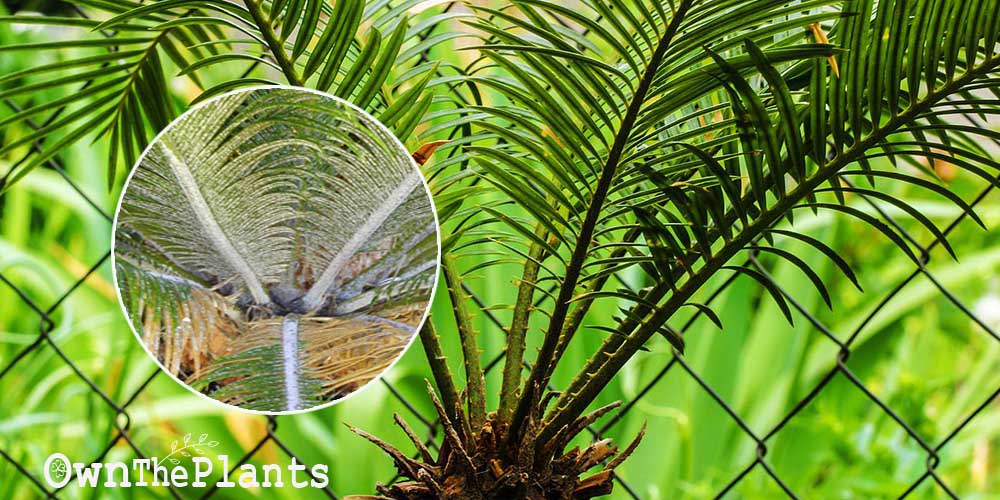Despite their name, sago palms are not actually palm trees. They are actually cycads.
Cycads are considered to be living fossils because they’ve survived since the times of the dinosaurs and haven’t changed much.
While they’re obviously fascinating and quite the survivor, they’re not invincible. If you see white spots on your sago palms, then you might have a problem that you need to deal with.
This is a growing risk to sago palm trees in warmer climates where they are more likely to grow and thrive.
White spots on sago palms might be naturally occurring pollen, or they might be an insect infestation.
Homeowners, gardeners, arborists, and lawn care professionals are among those that need to know how to determine the difference.
They also need to know the potential treatment techniques used in addressing the problem of white spots on a sago palm tree.
What Are White Spots on Sago Palm Trees?
White spots on sago palm trees can be one of two things. White powder on the male cone is usually just the plant’s own pollen.
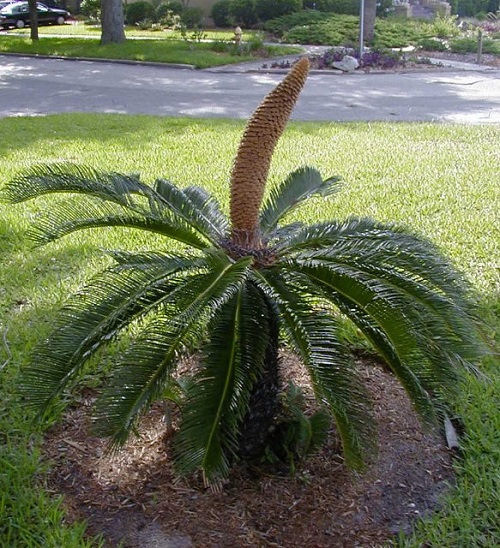
However, white spots elsewhere might be scurf, a form of plant dandruff, or a scale infestation of insects that eat away at your plant slowly.
Diagnosis
Determining the proper course of treatment means diagnosing the white spots accurately.
Fortunately, the telltale signs of each of the three have their own unique characteristics. You can use these to determine whether or not the white spots on your sago palm are pollen, scurf, or scale infestation.
Pollen
If pollen is the source of white spots on your sago palm, then it’s likely going to be on the male cone.
Wind, rain, and normal weather will normally take care of this pollen. However, if the sight of it disturbs you, then you might be able to brush or hose it off to restore the pristine look of your plant.
Scurf

Scurf is a kind of natural dandruff that some young leaves might develop. Scurf usually appears as small white bumps that are perhaps elongated. They eventually flake off when the leaves age.
Scale
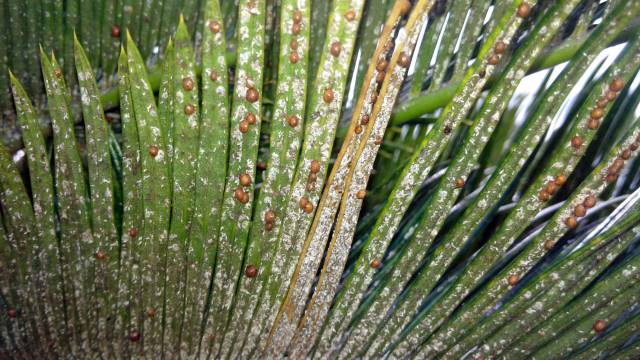
Scale insects look fuzzy or waxy in their appearance. You can check scurf and scale insects both by using a sterile knife to gently remove a tiny portion of the white before checking things out under a magnification device.
Scales are usually tiny insects sucking sap and life out of the tree.
Within the realm of scale insects, there are actually thousands of different individual species. Many feeds off of flowering plants. However, there are also many that dine on gymnosperms.
Gymnosperms are plants that produce seeds even without actually flowering. Conifers fall into this category, and so do some cacti. Cycads, the lesser-known name for sago palms, certainly fall into this category.
Some scale species make a hard and waxy coating. That offers them protection from insecticides and predators. Others are mobile, and few even fly.
Mealybugs are a kind of scale that happen so frequently they fall under a different category of pest compared to other scale insects.
Scale insects are almost vampiric in nature. They feed off of the sap of a plant. For instance, cycad scales wind up turning palm leaves into a yellow color.
When they initially pierce a plant, they use pressure to force sap throughout their system before it comes out the other end. The result is fecal matter and honeydew.
The white scale itself drains plant life slowly on its own. However, the honeydew is alluring to fungal spores. Sooty mold and powdery mildew are particular dangers to be wary of.
Also, ants harvest honeydew as a food source. They also use scale as predator protection.
Tips & Solutions For White Spots on Sago Palm Trees
Pollen is nothing to worry about, especially since it indicates the tree is likely healthy and flourishing.
Scurf is a condition you might want to deal with, and there are ways of doing this.
Scale infestation is something you need to deal with, and there are many techniques you can try to eliminate that as well.
Dealing With Scurf
Treating scurf isn’t always necessary. You might choose to just let the condition go through its cycle and then eventually fade away.
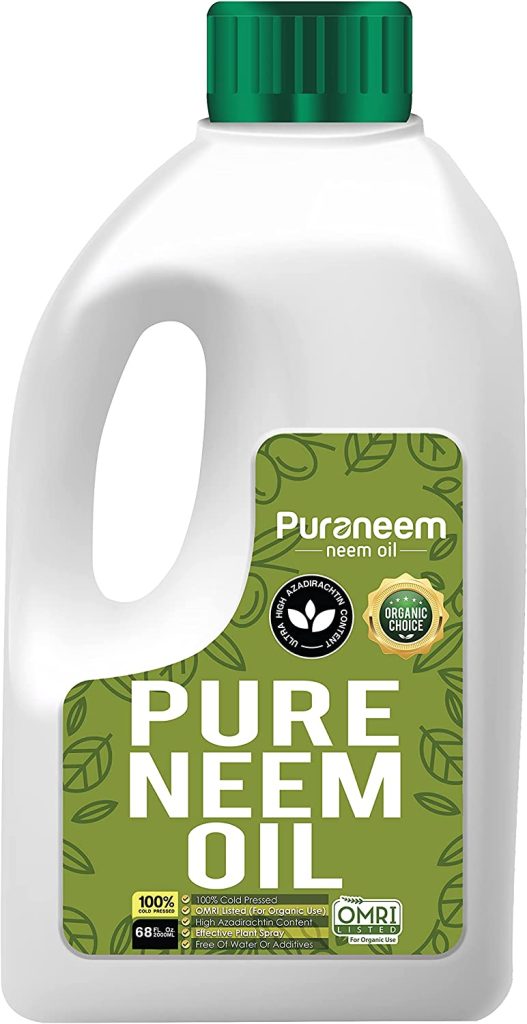
However, there is one good reason for treating scurf. That’s when it might be hiding sneaky scale. Fortunately, you can deal with both using a neem oil treatment.
It might seem counterintuitive to you to do a neem soil soak for white spots higher up on the plant. The upside of this treatment is how effective it is. The downside is how long it might take to do its work.
Start with water. Distilled water is the best choice if you can get it or make it. Let it be room temperature.
Emulsify your water with a teaspoon of per castile soap. You should use 1 teaspoon per gallon of water.
For each gallon, also add neem oil that is raw and 100% cold-pressed. Neem oil that’s cold-pressed works better because heat actually minimizes the effectiveness of neem oil. Add anywhere from 1 to 4 teaspoons per gallon.
Pour this drench around the base of your plant. Match the root spread the best you can with your radius. Don’t let any of it actually get on the plant.
Young sago palms only need 2 to 4 cups. Shrub- and tree-scale plants need more.
Raw neem’s active ingredient is azadirachtin. When plants absorb it, it winds up being a systemic insecticide. It will kill piercing insects and also certain infections for just over three weeks.
Do reapplications in 2 to 3-week intervals. You can do these as both treatment or just preventative actions.
Dealing With Scale Infestation
When you’re dealing with white scales, they’re tiny insects that are physically sucking the plant’s sap out.
They’re very adept at hiding, so they’re not easy to get rid of. However, it’s not impossible, and you have multiple options.
When they get done feeding, they leave a sticky substance behind. This is something many gardeners call honeydew.
It’s another round of problems because it can attract flies and ants, trap fungal spores, and even block light from hitting the leaves.
(1) If you’ve already tried neem oil treatments at the base, then pruning might be your next move. If you prune, use only sterile tools. Be sure to put your prunings in a bag you can seal properly, and dispose of them a good distance from the tree.
(2) Isopropyl alcohol is another option. Pour some onto a cotton swab so you can dab your plant leaves to kill scale and remove honeydew. Do this weekly or even semi-weekly to be sure you permanently remove scales.
(3) Scarping might be necessary when too many scales are in place already. Use your fingernails or another object to pluck off the scales. Just remember you’ll need to utilize other methods to prevent the spread of scales you can’t see.
(4) Natural predators are another choice for keeping your plants safe. Ladybugs are often pretty to look at, but they’re also very effective in hunting down and destroying scale insect infestations.
Do what you can to draw predatory insects to your yard, especially around your sago palm trees.
(5) Horticultural sprays are something else you can use. If you do go this route, then apply them to the entire tree and not just areas visibly impacted.
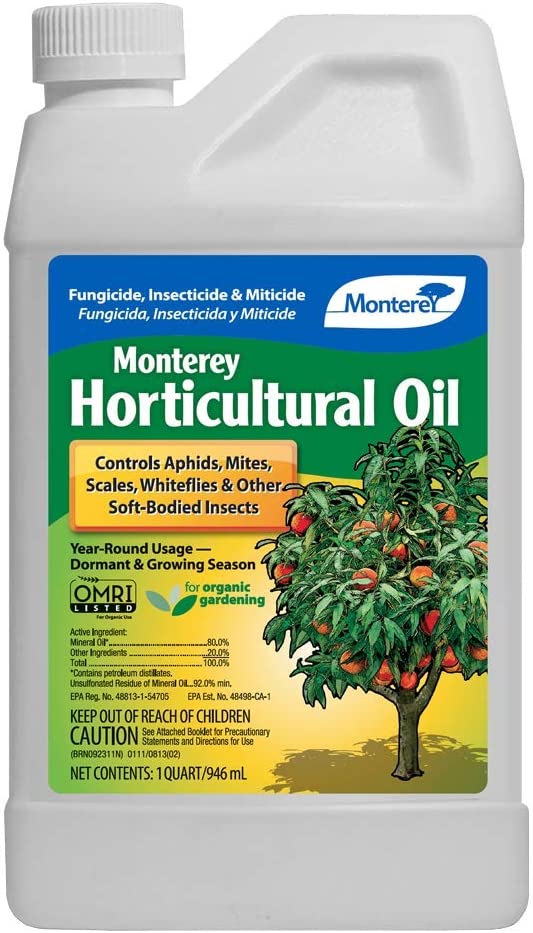
Be sure you get both sides of all leaves and all nooks, crannies, and crevices on the overall tree.
Key Takeaways
Your sago palm tree is a unique piece of living history that brings a beautiful look to your yard or property.
Seeing white spots on it can be a cause for concern, but you need to study those spots to determine what kind they are, so you see if they’re a problem or not.
Pollen isn’t something to get worried about, but scurf and scale infestations should be responded to promptly and properly.
Seeing white spots on your sago palm might make you panic, but you should stay calm. When you get a minute, look to see where the white spots are and what kind of texture they have.
If a gentle hosing or a rainstorm washes it away, then you probably have nothing to worry about.
If it appears to be scurf or scale, then start with a neem oil treatment. Pruning is the next step.
If you determine that it is scale your sago palm has, then do everything you can to contain it before it leads to other problems.
These can include fungal spores and more insects. Continue treatment as a preventative measure even after you no longer see the white spots.
Anything that happened once can happen again. Then again, any technique you use successfully once can also work again, too.
